AD/RANS Simulations of Wind Turbine Wake Flow Employing the RSM Turbulence Model: Impact of Isotropic and Anisotropic Inflow Conditions
Abstract
1. Introduction
2. Numerical Methodologies
2.1. Governing Equations
2.2. Reynolds Stress Model (RSM)
2.3. Actuator Disc Model
3. Computational Settings
3.1. Computational Domain and Boundary Conditions
3.2. Isotropic and Anisotropic Inflow Conditions
4. Results and Discussion
4.1. Case 1: Wind Tunnel Experiment (WiRE Rotor)
4.2. Case 2: Field Measurements (Sexbierum Wind Farm)
4.3. Case 3: Field Measurements (Nibe Wind farm)
4.4. Case 4: AD/LES Simulation (Vestas 2MW Wind Turbine)
5. Conclusions
Author Contributions
Funding
Acknowledgments
Conflicts of Interest
References
- Bouras, I.; Ma, L.; Ingham, D.; Pourkashanian, M. An improved k–ω turbulence model for the simulations of the wind turbine wakes in a neutral atmospheric boundary layer flow. J. Wind Eng. Ind. Aerodyn. 2018, 179, 358–368. [Google Scholar] [CrossRef]
- Antonini, E.G.A.; Romero, D.A.; Amon, C.H. Improving cfd wind farm simulations incorporating wind direction uncertainty. Renew. Energy 2019, 133, 1011–1023. [Google Scholar] [CrossRef]
- Hu, J.; Yang, Q.; Zhang, J. Study on the wake of a miniature wind turbine using the reynolds stress model. Energies 2016, 9, 784. [Google Scholar] [CrossRef]
- Wu, Y.-T.; Porté-Agel, F. Large-eddy simulation of wind-turbine wakes: Evaluation of turbine parametrisations. Bound. Layer Meteorol. 2011, 138, 345–366. [Google Scholar] [CrossRef]
- AbdelSalam, A.M.; Ramalingam, V. Wake prediction of horizontal-axis wind turbine using full-rotor modeling. J. Wind Eng. Ind. Aerodyn. 2014, 124, 7–19. [Google Scholar] [CrossRef]
- Göçmen, T.; Laan, P.V.D.; Réthoré, P.-E.; Diaz, A.P.; Larsen, G.C.; Ott, S. Wind turbine wake models developed at the technical university of denmark: A review. Renew. Sustain. Energy Rev. 2016, 60, 752–769. [Google Scholar] [CrossRef]
- Behrouzifar, A.; Darbandi, M. An improved actuator disc model for the numerical prediction of the far-wake region of a horizontal axis wind turbine and its performance. Energy Convers. Manag. 2019, 185, 482–495. [Google Scholar] [CrossRef]
- Shives, M.; Crawford, C. Adapted two-equation turbulence closures for actuator disk rans simulations of wind & tidal turbine wakes. Renew. Energy 2016, 92, 273–292. [Google Scholar]
- Makridis, A.; Chick, J. Validation of a cfd model of wind turbine wakes with terrain effects. J. Wind Eng. Ind. Aerodyn. 2013, 123, 12–29. [Google Scholar] [CrossRef]
- Ren, H.; Zhang, X.; Kang, S.; Liang, S. Actuator disc approach of wind turbine wake simulation considering balance of turbulence kinetic energy. Energies 2018, 12, 16. [Google Scholar] [CrossRef]
- Laan, M.P.; Sørensen, N.N.; Réthoré, P.E.; Mann, J.; Kelly, M.C.; Troldborg, N.; Schepers, J.G.; Machefaux, E. An improved k-ϵ model applied to a wind turbine wake in atmospheric turbulence. Wind Energy 2015, 18, 889–907. [Google Scholar] [CrossRef]
- Rocha, P.A.C.; Rocha, H.H.B.; Carneiro, F.O.M.; Vieira da Silva, M.E.; Bueno, A.V. K–ω sst (shear stress transport) turbulence model calibration: A case study on a small scale horizontal axis wind turbine. Energy 2014, 65, 412–418. [Google Scholar] [CrossRef]
- Abkar, M.; Porté-Agel, F. Influence of atmospheric stability on wind-turbine wakes: A large-eddy simulation study. Phys. Fluids 2015, 27, 035104. [Google Scholar] [CrossRef]
- El Kasmi, A.; Masson, C. An extended k–ε model for turbulent flow through horizontal-axis wind turbines. J. Wind Eng. Ind. Aerodyn. 2008, 96, 103–122. [Google Scholar] [CrossRef]
- Prospathopoulos, J.M.; Politis, E.S.; Rados, K.G.; Chaviaropoulos, P.K. Evaluation of the effects of turbulence model enhancements on wind turbine wake predictions. Wind Energy 2011, 14, 285–300. [Google Scholar] [CrossRef]
- Réthoré, P.E.; Laan, P.; Troldborg, N.; Zahle, F.; Sørensen, N.N. Verification and validation of an actuator disc model. Wind Energy 2014, 17, 919–937. [Google Scholar] [CrossRef]
- Gómez-Elvira, R.; Crespo, A.; Migoya, E.; Manuel, F.; Hernández, J. Anisotropy of turbulence in wind turbine wakes. J. Wind Eng. Ind. Aerodyn. 2005, 93, 797–814. [Google Scholar] [CrossRef]
- Cabezón, D.; Migoya, E.; Crespo, A. Comparison of turbulence models for the computational fluid dynamics simulation of wind turbine wakes in the atmospheric boundary layer. Wind Energy 2011, 14, 909–921. [Google Scholar] [CrossRef]
- Nguyen, V.T.; Guillou, S.S.; Thiébot, J.; Cruz, A.S. Modelling turbulence with an actuator disk representing a tidal turbine. Renew. Energy 2016, 97, 625–635. [Google Scholar] [CrossRef]
- Bai, G.; Li, J.; Fan, P.; Li, G. Numerical investigations of the effects of different arrays on power extractions of horizontal axis tidal current turbines. Renew. Energy 2013, 53, 180–186. [Google Scholar] [CrossRef]
- Tian, L.; Zhao, N.; Wang, T.; Zhu, W.; Shen, W. Assessment of inflow boundary conditions for rans simulations of neutral abl and wind turbine wake flow. J. Wind Eng. Ind. Aerodyn. 2018, 179, 215–228. [Google Scholar] [CrossRef]
- Lam, W.H.; Robinson, D.J.; Hamill, G.A.; Johnston, H.T. An effective method for comparing the turbulence intensity from lda measurements and cfd predictions within a ship propeller jet. Ocean Eng. 2012, 52, 105–124. [Google Scholar] [CrossRef]
- ANSYS Inc. Ansys Fluent 14.0 Theory Guide; ANSYS Inc.: Canonsburg, PA, USA, 2011; pp. 1–390. [Google Scholar]
- Aubrun, S.; Loyer, S.; Hancock, P.E.; Hayden, P. Wind turbine wake properties: Comparison between a non-rotating simplified wind turbine model and a rotating model. J. Wind Eng. Ind. Aerodyn. 2013, 120, 1–8. [Google Scholar] [CrossRef]
- Yu, H.; Thé, J. Validation and optimization of sst k-ω turbulence model for pollutant dispersion within a building array. Atmos. Environ. 2016, 145, 225–238. [Google Scholar] [CrossRef]
- Richards, P.; Norris, S. Appropriate boundary conditions for computational wind engineering models revisited. J. Wind Eng. Ind. Aerodyn. 2011, 99, 257–266. [Google Scholar] [CrossRef]
- Panofsky, H.A.; Dutton, J.A. Atmospheric Turbulence: Models and Methods for Engineering Applications; Wiley-Interscience: New York, NY, USA, 1984. [Google Scholar]
- Uchida, T. Design wind speed evaluation technique in wind turbine installation point by using the meteorological and cfd models. J. Flow Control Meas. Vis. 2018, 6, 168–184. [Google Scholar] [CrossRef]
- Chamorro, L.P.; Porté-Agel, F. A wind-tunnel investigation of wind-turbine wakes: Boundary-layer turbulence effects. Bound. Layer Meteorol. 2009, 132, 129–149. [Google Scholar] [CrossRef]
- Stevens, R.J.A.M.; Martínez-Tossas, L.A.; Meneveau, C. Comparison of wind farm large eddy simulations using actuator disk and actuator line models with wind tunnel experiments. Renew. Energy 2018, 116, 470–478. [Google Scholar] [CrossRef]
- Pfeiler, C.; Raupenstrauch, H. Application of different turbulence models to study the effect of local anisotropy for a non-premixed piloted methane flame. In Computer Aided Chemical Engineering; Pierucci, S., Ferraris, G.B., Eds.; Elsevier: Amsterdam, The Netherlands, 2010; Volume 28, pp. 49–54. [Google Scholar]
- Chen, Y.; Lin, B.; Lin, J.; Wang, S. Experimental study of wake structure behind a horizontal axis tidal stream turbine. Appl. Energy 2017, 196, 82–96. [Google Scholar] [CrossRef]
- Cleijne, J.W. Results of Sexbierum Wind Farm: Single Wake Measurements; TNO Institute of Environmental and Energy: Apeldoorn, The Netherlands, 1993; pp. 1–141. [Google Scholar]
- Peña, A.; Réthoré, P.-E.; van der Laan, M.P. On the application of the jensen wake model using a turbulence-dependent wake decay coefficient: The sexbierum case. Wind Energy 2016, 19, 763–776. [Google Scholar] [CrossRef]
- Taylor, G. Wake Measurements on the Nibe Wind-Turbines in Denmark: Data Collection and Analysis; National Power, Technology and Environment Centre: Harwell, UK, 1990. [Google Scholar]
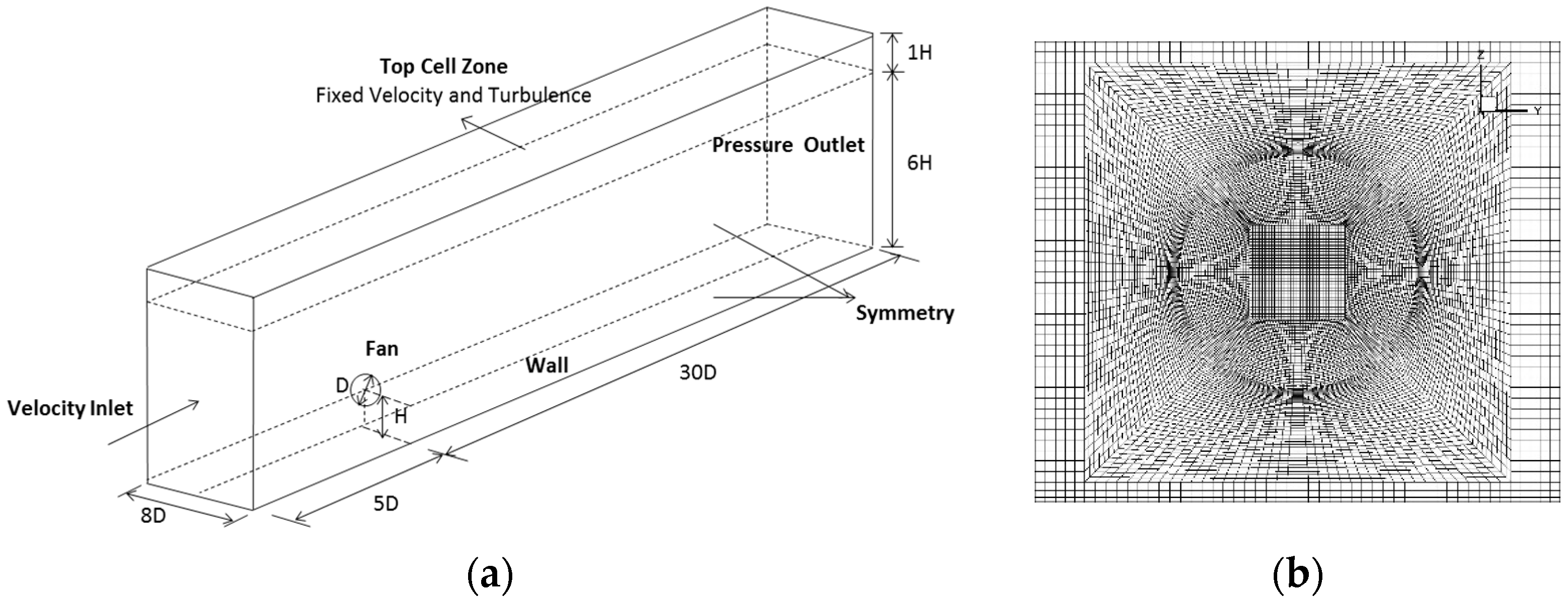
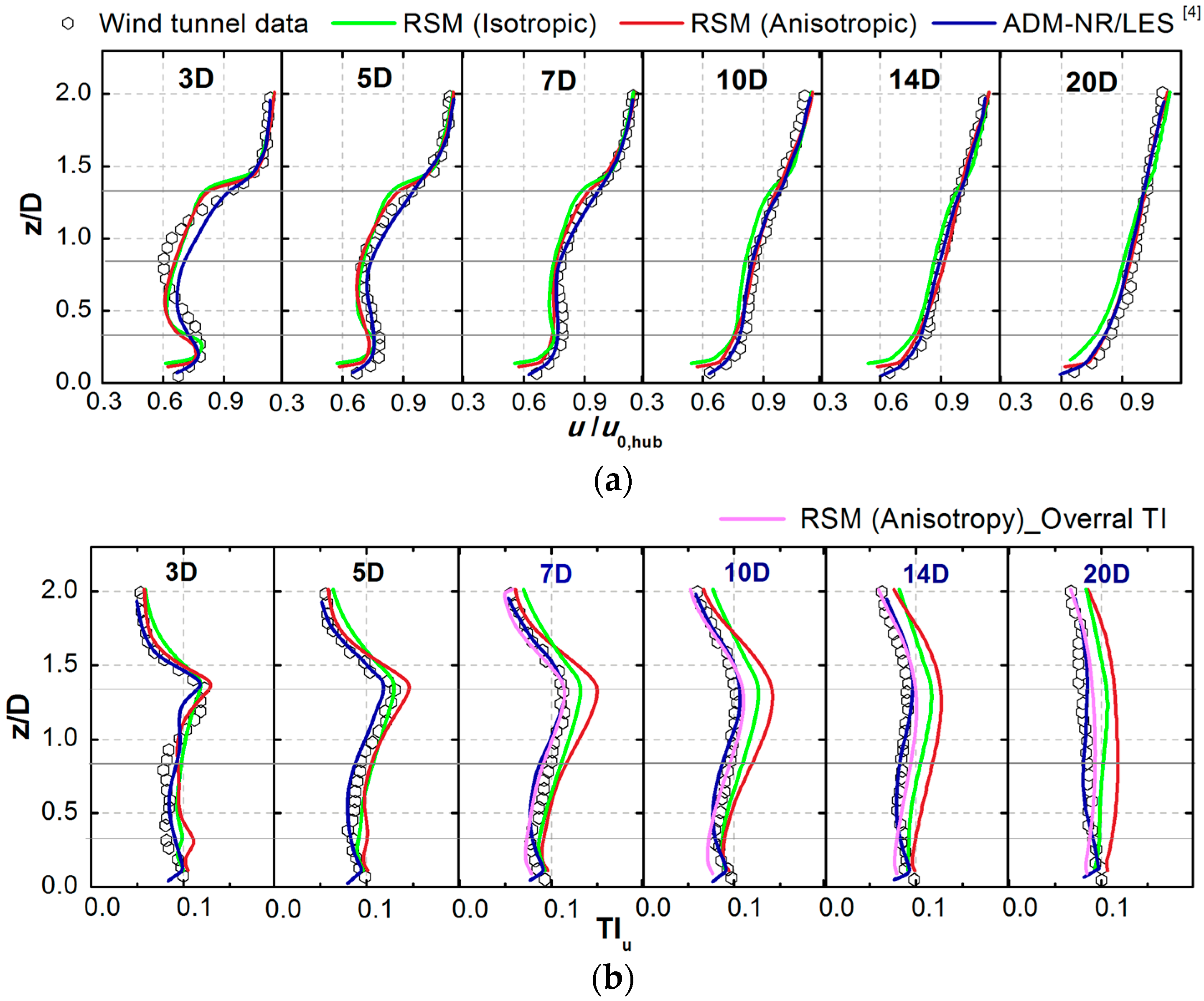

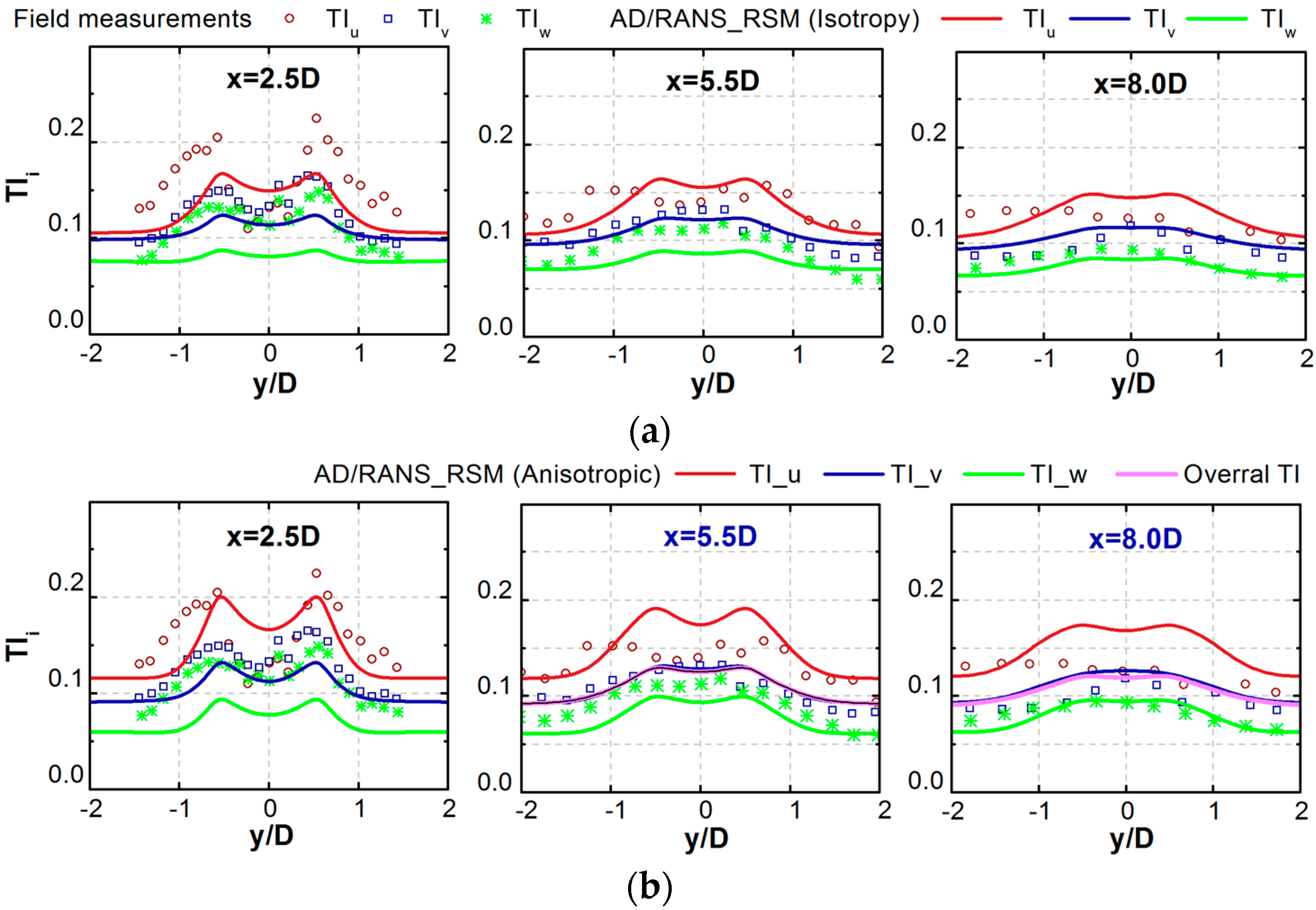
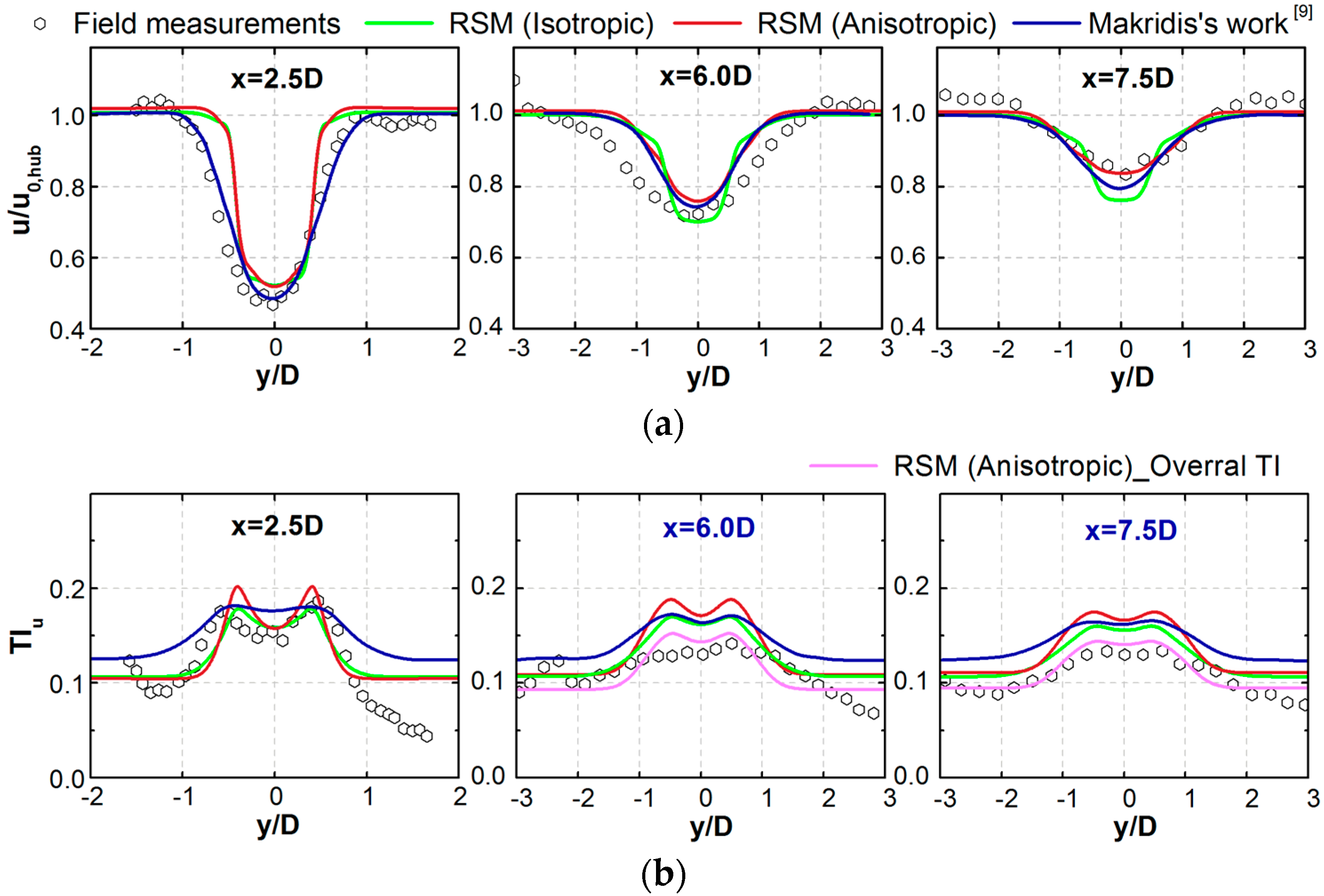
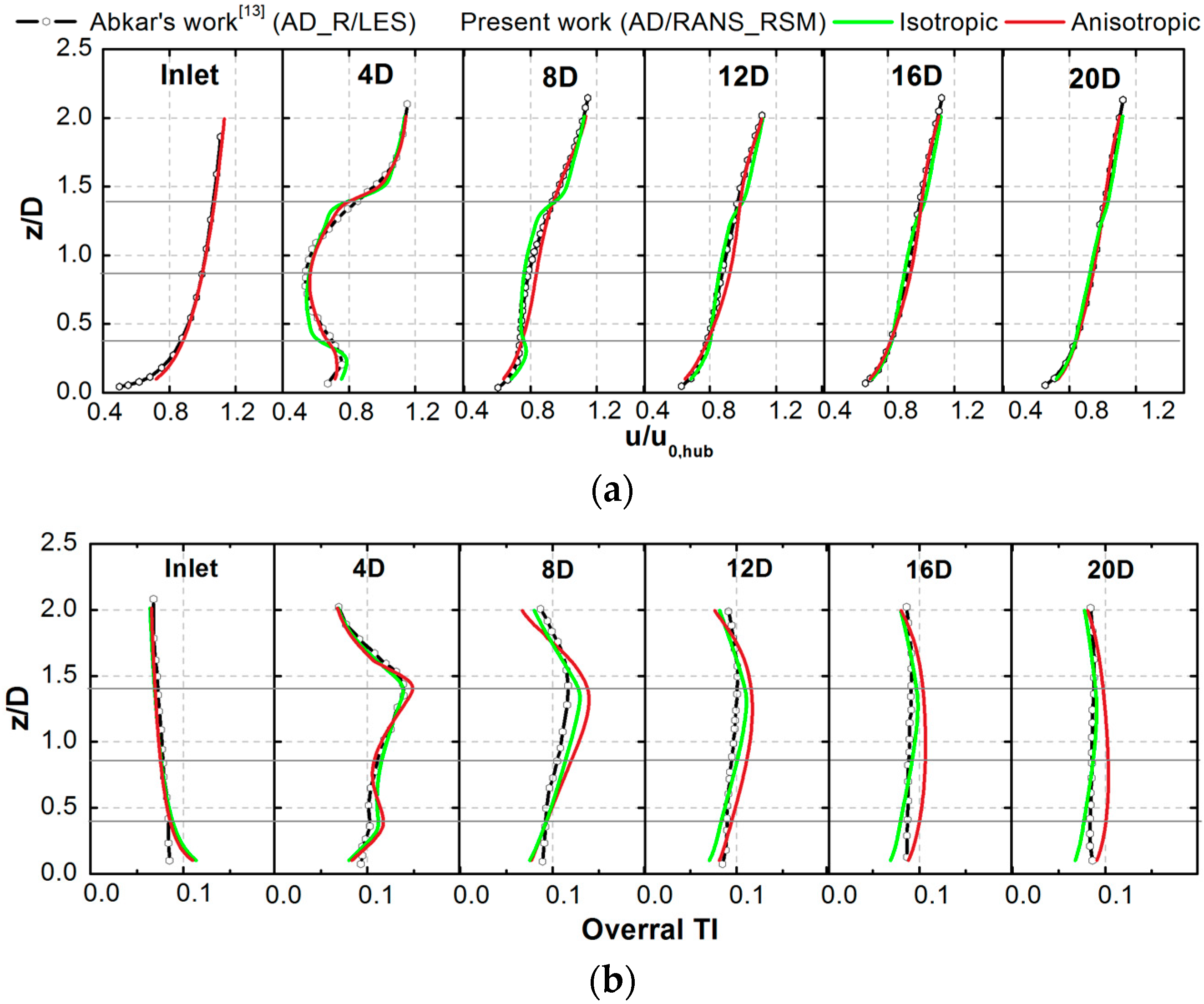
| CFD Computational Settings | |
|---|---|
| Computational domain size | 35D in the axial direction (x), 8D in the cross direction (y) and 7H in the vertical direction |
| Grid growing ratio | At most 1.06 in both horizontal and vertical directions |
| Wall layer grids | y+ ~ [30, 300] |
| Turbine rotor | Additional source term (described in Section 2.3) |
| Inflow boundary | Profiles of incoming wind flow quantities (described in Section 3.2) |
| Outflow boundary | Zero gradient condition |
| Ground | No slip boundary condition with the modified wall function in [21] |
| Lateral boundaries | Symmetry condition |
| Top zone | Dirichlet boundary condition with a fixed velocity and turbulence |
| Solving algorithm | SIMPLEC algorithm for the pressure-velocity coupling, Least squares cell-based gradient scheme for diffusion term, second order difference schemes for pressure and advection terms |
| Convergence criteria | Below 1 × 10−6 for scaled residuals of all variables |
| Isotropic Inflow Profiles | Anisotropic Inflow Profiles | ||
|---|---|---|---|
| Vertical velocity profile u(z) | (4) | ||
| Vertical profile of turbulence intensity TI(z) | (5) | ||
| Vertical profile of turbulent kinetic energy k(z) | for isotropic inflow; , where for anisotropic inflow | (6) | |
| Vertical profile of turbulence dissipation rate ε(z) | (7) | ||
| Vertical profile of specific turbulence dissipation rate ω(z) | (8) | ||
| Reynolds stress profiles | (9) | (10) | |
| Turbulence model constants | |||
| Downstream Positions | 3D | 5D | 7D | 10D | 14D | 20D |
|---|---|---|---|---|---|---|
| Eave of u (%) | 5.0 | 4.1 | 2.7 | 2.1 | 1.4 | 1.2 |
| Emax of u (%) | 13.2 | 8.4 | 6.9 | 6.1 | 5.4 | 4.6 |
| Eave of TIu (%) | 11.3 | 12.1 | 4.6 | 4.4 | 6.3 | 7.1 |
| Emax of TIu (%) | 28.1 | 23.7 | 11.1 | 15.3 | 12.9 | 14.6 |
© 2019 by the authors. Licensee MDPI, Basel, Switzerland. This article is an open access article distributed under the terms and conditions of the Creative Commons Attribution (CC BY) license (http://creativecommons.org/licenses/by/4.0/).
Share and Cite
Tian, L.; Song, Y.; Zhao, N.; Shen, W.; Wang, T. AD/RANS Simulations of Wind Turbine Wake Flow Employing the RSM Turbulence Model: Impact of Isotropic and Anisotropic Inflow Conditions. Energies 2019, 12, 4026. https://doi.org/10.3390/en12214026
Tian L, Song Y, Zhao N, Shen W, Wang T. AD/RANS Simulations of Wind Turbine Wake Flow Employing the RSM Turbulence Model: Impact of Isotropic and Anisotropic Inflow Conditions. Energies. 2019; 12(21):4026. https://doi.org/10.3390/en12214026
Chicago/Turabian StyleTian, Linlin, Yilei Song, Ning Zhao, Wenzhong Shen, and Tongguang Wang. 2019. "AD/RANS Simulations of Wind Turbine Wake Flow Employing the RSM Turbulence Model: Impact of Isotropic and Anisotropic Inflow Conditions" Energies 12, no. 21: 4026. https://doi.org/10.3390/en12214026
APA StyleTian, L., Song, Y., Zhao, N., Shen, W., & Wang, T. (2019). AD/RANS Simulations of Wind Turbine Wake Flow Employing the RSM Turbulence Model: Impact of Isotropic and Anisotropic Inflow Conditions. Energies, 12(21), 4026. https://doi.org/10.3390/en12214026






